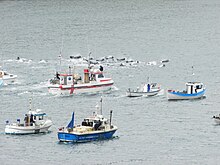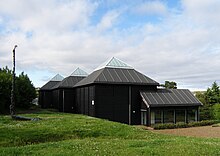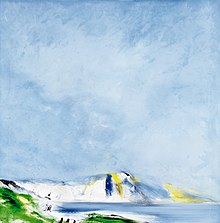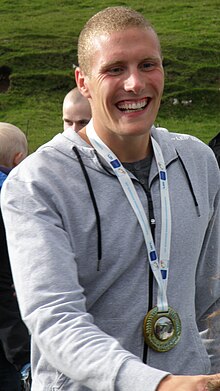Culture of the Faroe Islands
The Faroe Islands were long isolated from the main cultural phases and movements that swept across parts of Europe.
Until the 15th century, Faroese had a similar orthography to Icelandic and Norwegian, but after the Reformation in 1538, the ruling Danes outlawed its use in schools, churches and official documents.
These works were split into the following divisions: sagnir (historical), ævintyr (stories) and kvæði (ballads, often set to music and the mediaeval chain dance).
There are no musical instruments used along with the dance, the dancers are singing ballads of various lengths, in either Faroese language or Danish, the latter of which is pronounced in Gøtudanskt.
A ballad can be very long with a couple of hundred verses, which the skipari is expected to know by heart The following description is by V. U. Hammershaimb, Færøsk Anthologi, 1891: The storyline of the ballad is attended by everybody with great interest, and if something especially pleasant or moving occurs, you can see it in the look and movement of the dancers – when the rage of the battle is described, the hands are clenched together, and when victory is in hand, they make cheering movements.Such is the importance of the dance as a cultural element that the Faroese refer to it as Faroese dance.
[4][5][6] However, a study has found whale meat and blubber to currently be contaminated with mercury and not recommended for human consumption, as too much may cause such adverse health effects as birth defects of the nervous system, high blood pressure, damaged immune system, increased risk for developing Parkinson's disease, hypertension, arteriosclerosis, and Diabetes mellitus type 2: Therefore we recommend that adults eat no more than one to two meals a month.
[7]Animal rights groups such as the Sea Shepherd Conservation Society criticize it as being cruel and unnecessary, since it is no longer necessary as a food source for the Faroese people.
Other famous authors from the Faroes include Heðin Brú (The Old Man and His Sons) and Jóanes Nielsen.
Famous Faroese painters include Sámuel Joensen-Mikines, Ingálvur av Reyni, Ruth Smith, Tróndur Patursson, Steffan Danielsen and Amariel Norðoy among others.
[14] In 1995 the German painter Ingo Kühl visited the Faroes and painted a serie of pictures Färöer.
Each shawl consists of two triangular side panels, a trapezoid-shaped back gusset, an edge treatment, and usually shoulder shaping.
As of 1 July 2008, the Faroe Islands' international record (in UEFA European Championships qualifiers) was played 48, won 3, drawn 5, lost 40.
The regattas in between the Norðoyastevna and Ólavsøka are held in these locations: Jóansøka is every even year held in Vágur and every odd year in Tvøroyri, both villages are in Suðuroy (South Island), and this is the only place which is not possible to drive by car from Tórshavn, people have to take the ferry Smyril to Suðuroy, which is a two-hour journey.
The Faroese freestyle swimmer Pál Joensen is the sportsperson of the Faroe Islands with the best international result for the country, a bronze medal at the 2012 FINA World Swimming Championships.
[18] In 2010, Joensen won silver in the 1500 meter freestyle swimming event at the European Aquatics Championship.
Pál Joensen has moved to live and study in Denmark after finishing high school in the Faroe Islands in August 2012.
Christina Næss won the first and only (until now 9 September 2012) gold medal for the Faroe Islands at the 1988 Summer Paralympics.
Katrin Johansen, Tóra við Keldu and Heidi Andreasen have won silver or bronze medals at the Paralympics.










